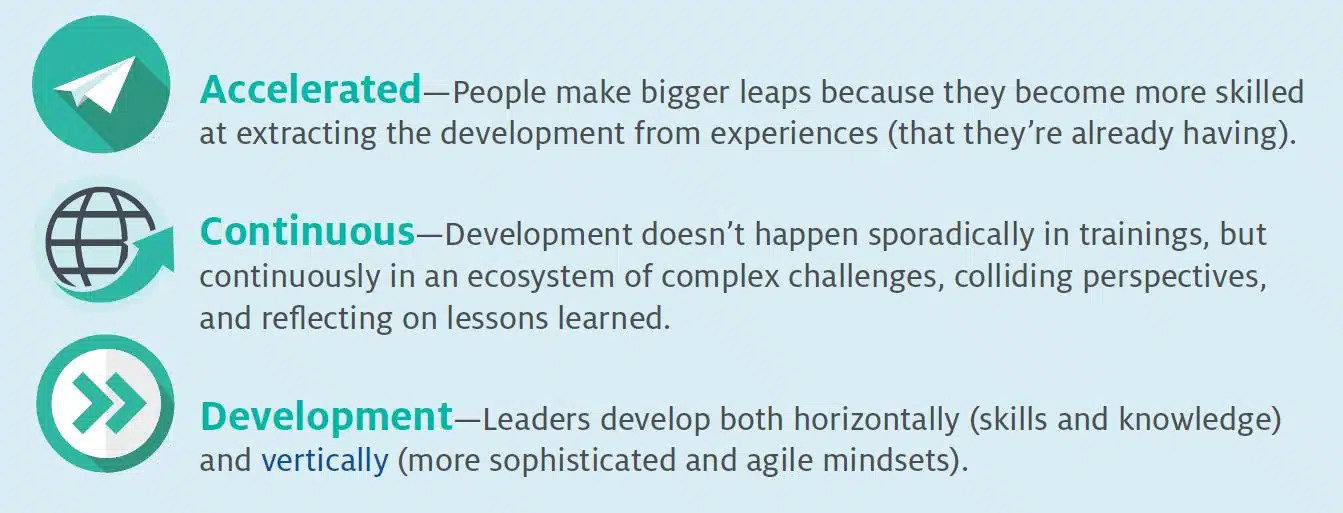The Leadership Development Hacks We’ve Learned From Developing Leaders in the Tech Industry
The technology-driven, risk-infused, growth-obsessed world of Silicon Valley companies is different from the rest of the corporate world, our research has confirmed.
We wanted to know: Is leadership development in Silicon Valley any different? And if it is, how?
To answer these questions, our researchers undertook a year-long research project. We talked to executives and Learning & Development professionals at some of Silicon Valley’s largest companies, including Google, Facebook, and LinkedIn.
In the process, we uncovered and helped implement some of the Valley’s best leadership development “hacks” — methods that meet the unusual development needs of leadership in the tech industry.
Why Leadership Development in the Technology Industry Is Different
In our experience, leadership development at Silicon Valley companies is somewhat different from other organizations in several ways:
- The speed of change. Businesses move at an accelerated pace in the tech sector. They often operate on 3-month plans (because things change too quickly to plan beyond that). Many are seeking to double their size in the next 12–24 months.
- Intense competition for talent. Companies live or die based on their talent, and employees can and do move around.
- Focus on culture. Companies are proud of their corporate cultures and use them to keep and recruit talent.
- High levels of stress. Workloads are enormous in Silicon Valley. The often-young leaders and employees feel under pressure constantly.
- Common needs among tech leaders. Leadership development in this industry is focused on basic management skills, emotional intelligence, stress management skills, the ability to manage globally dispersed teams, and being able to influence rather than just tell people what to do.
- An allergic reaction to common leadership development practices. Many Silicon Valley leaders don’t like off-the-shelf content. They want solutions supported by research. And, perhaps surprisingly, they often eschew training that is purely delivered digitally.
Apply Accelerated Continuous Development (ACD) for Leaders in Tech
Many successful tech companies and Silicon Valley start-ups have developed an approach to meeting their leadership development needs that we call Accelerated Continuous Development (ACD).
The goal of ACD is to help young leaders develop faster, learn continuously on the job, and increase their skills and knowledge while also developing more sophisticated, agile mindsets.
Leadership Development “Hacks” We’ve Learned
Key Learnings from Our Partnerships With Tech Industry Clients
We have identified 7 key practices that companies use to successfully implement ACD:
- Give leaders heat experiences.
- Build ecosystems of peer-to-peer learning.
- Company data + your culture = leadership hacks.
- Develop leaders through 3 circles.
- Design solutions for time-poor leaders.
- Build snackable and deep-dive solutions.
- Protect your asset: Create a low-stress, high-energy culture.
Here, we’ll discuss 2 of those practices (read our full white paper for the rest):
- Design solutions for time-poor leaders.
- Create a low-stress, high-energy culture.
1. Make development solutions work for time-poor leaders.
Technology leaders won’t take part in leadership development if it’s not connected to their work. And the time that traditional development programs take is unworkable.
The solution? “Snackable” learning that’s easy to schedule and connects to a leader’s current needs. Some companies use an app called Adeption. Users can select a specific challenge, such as “resistance to change.” The app shows what other leaders have done in response and what their outcomes were. It also points the user toward related research and resources.
Another way to create snackable learning is to focus on proven solutions that can be quickly taught to leaders when they need them. This is especially useful for topics such as giving feedback that many young technology leaders may not have ever received any formal training in. Some Silicon Valley development managers see themselves as “curators,” collecting high-quality content and tools and then packaging them for their in-house leaders.
Finally, to make leadership development attractive, consider finding creative ways to connect it to key company priorities. One company struggled to get senior leaders to participate, even with the CEO’s encouragement. But when the Learning & Development team invited customers to the sessions, senior leaders were excited to attend because it gave them an opportunity to spend time with and learn from their customers — an activity that aligned closely with their roles and the company’s customer-centric culture.
2. Create a low-stress, but high-energy culture.
When we measured stress on 8 psychometric scales, we found that tech industry leaders in Silicon Valley have the highest levels of stress we’d seen in any industry.
Technology companies often operate in markets that change quickly and unpredictably. New competitors enter, sometimes new products and services are untested; pressure to grow revenue quickly is high.
Add to this that many technology leaders are promoted into their roles at young ages — in their 20s or 30s — and you have a perfect recipe for high stress. Their peers in other industries might be 20 years older than them and have had more time to develop coping skills and build resilience.
But this is a solvable problem. In one high-pressure company, we taught leaders research-proven methods to reduce stress and increase resilience. Those managers practiced those techniques and then taught them to their teams through one-hour meetings that included short video demonstrations and a discussion of how to apply them. Within a month, 1,200 employees had been trained in these tools.
| Habitual Responses to Change | Psychometric Test Scores | |
|---|---|---|
| 2015 | 2016 | |
| Rumination | 3.6 | 2.7 |
| Emotional Inhibition | 3.7 | 3.0 |
| Toxic Achieving | 3.8 | 2.7 |
| Avoidance Coping | 2.0 | 2.1 |
| Perfectionism | 4.5 | 2.9 |
The results? Despite a large layoff, measures of resilience improved from one year to the next.
One More Leadership Development “Hack” We’ve Learned: Be Context-Agnostic
If previous leadership development models (like the famed 70-20-10 rule) suggested a certain percentage of learning happens on the job while a certain percentage in the classroom, the new model says, “Who cares?”
More and more, previous models of development are becoming less relevant. Leadership development designers used to plan when and where their leaders would learn, but new generations of leaders don’t need to be told. People can now use leadership development tools and training materials, learning and developing at any time, in any context, from anywhere. What matters more is that you cultivate a learning culture at your organization.
So, the key leadership development “hack” we’ve learned? Become agnostic about the context where development happens: The future is about what is being consumed, and how it’s being integrated and applied.
Ready to Take the Next Step?
Build, scale, and integrate development by partnering with us to apply these leadership development hacks at your organization. Partner with us for customized leadership solutions for your organizations; we understand the unique considerations for leadership development in the technology sector.









